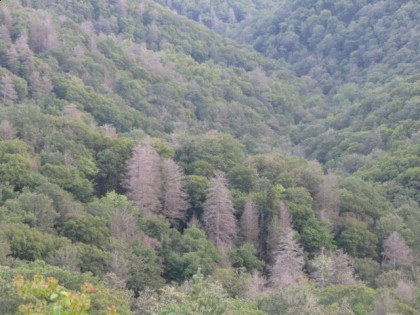Last fall, the U.S. Forest Service in North Carolina began using some new approaches to address hemlock trees under attack by the hemlock woolly adelgid in Western North Carolina’s national forests. The insects, which look like tiny white fluffy masses on the trees, continue to kill eastern and Carolina hemlocks throughout their range, including WNC. Thousands of trees — no one knows for sure how many — have died across the landscape here, diminishing a keystone species that’s been part of the local ecosystem for millennia. In this photo, the damaged and possibly dead trees stand out as gray sentinels in the forest.

photo courtesy of the U.S. Forest Service
The Forest Service and a team of partners recently reported some success in their efforts to protect trees from these tiny killers. The new treatment options have included aerial application of an adelgid-killing fungus; use of the chemical dinotefuran in high-priority areas where trees are in immediate danger of dying; expanding the number of sites that will be treated; releasing new species of predator beetles as they are evaluated; and allowing the use of the longer-lasting chemical, imidacloprid. Soil injection of insecticides have proven effective in reducing adelgid populations, according to an agency statement. Predatory beetles have been released in several areas across the two national forests, with additional species of beetles studied as options by partner researchers and universities. An adelgid-killing fungus applied through aerial spray is under consideration for future use.
Back in August, Forest Supervisor Marisue Hilliard said, “We intend to use all appropriate tools in conserving hemlock for future generations.” Hilliard’s decision allowed expansion of the hemlock treatment areas, both to replace hemlock stands that were lost to the disease, and to add more areas overall. In addition, the wider range of treatments were intended to allow forest managers a broader selection of approaches for different areas, many of which occur adjacent to trout streams.


At this point, hemlock trees will pretty much have to start over from scratch. The die off is too severe. They will be able to do this IF actual beetle predators and this fungus work and can persist in the environment in balance with the adelgid.
We injected our hemlocks 3 years ago with imidacloprid. It was expensive but cheaper than having them taken down. Now they are lush and healthy. It’s amazing to see the difference between the treated trees and the ones that are declining. In all, we saved 27 trees around are property. The company that we bought the imidacloprid is Mauget. It’s a regulated item and you are required to take a 1 day training course on using the chemical. It was certainly worth the efforts.
I am happy to see the hemlocks are being treated and the treatment works! Nice job!